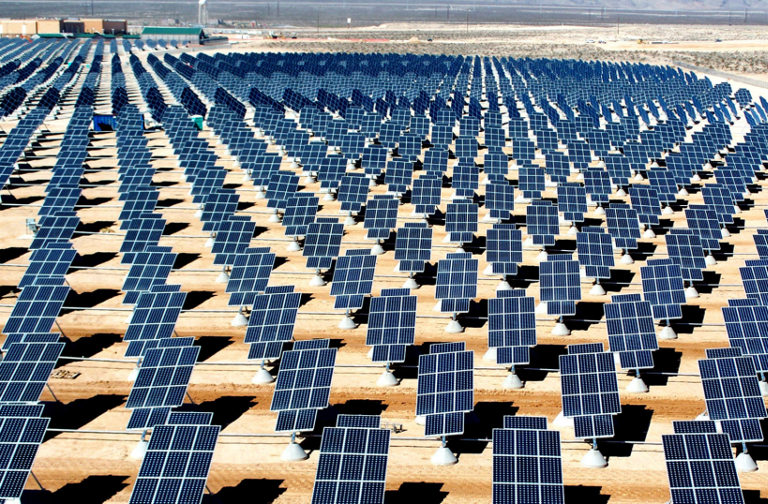Environmental issues such as polluted drinking water in Michigan and harmful algal blooms in Florida could influence which candidates voters will support in this November’s midterm election, says Holly Burke, communications coordinator of the League of Conservation Voters.
“Water issues really resonate with voters in states where clean water has been a dramatic problem,” says Burke.
These issues may affect certain political candidates, but in some states ballot measures will be a more direct way for residents to weigh in on environmental issues. For those hoping that statewide initiatives will help to combat environmental rollbacks at the federal level by the Trump administration, this election will be a crucial test.
The statewide ballot initiative with the greatest environmental significance will be decided by voters in Washington state, which could signal a shift in climate change strategy.
Two other western states will take on clean energy standards, and water issues will appear on the ballots in three states, including a confusing measure in Florida that pairs offshore drilling with an unrelated measure on vaping.
“We’re seeing a lot of support for states to take the lead in the light of federal attacks on clean energy and climate,” says Bill Holland, state policy director for the League of Conservation Voters.
A Fee on Polluters
The biggest test will be nearly 3,000 miles from Washington, D.C., in Washington state. If voters approve Initiative 1631, Washington could significantly move the needle on climate action by being the first state to enact a fee on carbon emissions.
Carbon pricing bills have been proposed by a number of state legislatures, including Washington’s, but none have yet to pass in the United States. Now Washington voters will decide for themselves on the issue and if Initiative 1631 wins, it could trigger efforts in other states.
“We’re super excited and see it as a potential model nationwide,” says Holland.
The measure would put a fee of $15 per metric ton on carbon emissions, beginning in 2020. This fee would increase $2 every year until the state hits its 2035 greenhouse gas reduction goals and is on track to meet its 2050 goals.
There’s a lot at stake, not just for Washington, but the whole country.
“If it passes, Washington will take its place as a part of a growing West Coast climate vanguard, alongside California and Oregon, representing close to 20 percent of the U.S. economy,” wrote David Roberts at Vox. “If it fails, it will not only be a crushing blow to an already battered state climate community, but it will cast doubt on the larger states-will-save-us narrative, which is just about the only narrative U.S. climate hawks have left.”
Just two years ago Washington voters rejected a similar measure, Initiative 732, which would have created a carbon tax. The measures, however, aren’t identical. A carbon tax would have directed revenue generated by the program to the state’s general fund. This year’s Initiative 1631 instead uses a fee, which directs the money to specific purposes.
Money raised by Initiative 1631 would be divvied up, with 70 percent directed toward supporting clean air and clean energy investments; 25 percent invested in clean water and healthy forests; and the remaining 5 percent targeted for helping communities deal with the impacts of climate change.
The initiative was put the ballot by a coalition of community, environment, labor and climate-justice groups.
The opposition, led by Western States Petroleum Association, has raised $21 million to defeat the measure, but Holland says he still likes the initiative’s chances of success. “Climate change is on the ballot and we think there is broad public support for holding polluters accountable,” he says.
Clean Water
Montana and Alaska voters will weigh in on water protections, but of two very different sorts.
In Montana Initiative 186 seeks to protect the state’s waters from pollution from new hardrock mines. It would give the state’s Department of Environment Quality the ability to deny permits for a new mine if the project’s plan doesn’t prove that it will prevent water pollution “without the need for perpetual treatment.”
The biggest financial supporter of the initiative is the fish-friendly nonprofit Trout Unlimited. Anglers have good reason for hoping to keep the state’s rivers clean and its fish populations healthy. The measure is opposed by mining interests led by the Montana Mining Association, which is concerned it would result in job losses and other economic damages.
The state is still dealing with the toxic legacy of earlier hardrock mines that have resulted in one of the country’s largest Superfund sites. And mining issues are still front and center. Montana’s Smith River was highlighted earlier in the year by the nonprofit American Rivers in its annual survey of the country’s “most endangered rivers” due to a proposed copper mine currently vying for permits.
Further north, Alaska’s Measure 1 would set up stricter permitting regulations and new requirements for projects that could impact aquatic habitat for salmon, steelhead and other anadromous fish, which migrate between rivers and the ocean.
“It enhances the public process and public participation in decisions around large-scale development that would impact salmon habitat, which is a core part of Alaska’s identity,” says Holland. The fish have not just environmental, but economic and cultural importance in the state.
Groups like the Alaska Center, Wild Salmon Center and Alaska Conservation Foundation are supporting the measure. It’s opposed by numerous oil drilling and mining companies, including BP Exploration Inc. Alaska, ConocoPhillips and Hecla Mining Company.
Drilling off Florida
One of the most confounding ballot initiatives will appear before Florida voters.
When voters get to Amendment 9 on this year’s ballot, they will decide whether to ban offshore oil and gas drilling in state waters. At the same time, they will vote on whether to allow vaping (the use of “vapor-generating electronic devices”) in indoor workplaces.
This odd confluence stems from the state’s strange initiative process. Florida’s Constitution Revision Commission only convenes every 20 years to decide which constitutional amendments to place on the ballot. In some cases they are grouped together.
The dual measure makes for odd bedfellows (and potentially voter confusion). A yes vote means a voter is in favor of banning both offshore drilling and indoor vaping. A no vote would be in support of drilling and vaping. If you’re in favor of one, but not the other, you’re out of luck.
Supporters of the measure are largely environmental groups opposed to drilling, while opponents are a mix of petroleum companies and the Consumer Advocates for Smoke-Free Alternatives Association.
Vaping aside, offshore drilling is gearing up to be a key issue. The Trump administration has worked to reverse offshore drilling moratoriums and safety regulations issued by Obama administration, and has sought to open most of the country’s waters to drilling.
Clean Energy Standards
Washington won’t be the only state voting on issues related to energy and climate.
Nevada’s Question 6 and Arizona’s Proposition 127 are both measures that would increase the state’s renewable portfolio standards, which is the minimum amount of electric power that utilities need to get from renewable sources. Both would bump the standards to 50 percent by 2030.
Nevada’s current renewable portfolio standard is 25 percent by 2025, but the state is already almost there. In 2016 it had 21.6 percent of electricity generation coming from geothermal, solar, wind, biomass and hydroelectric power sources. Of that mix of renewables, 44 percent came from geothermal. But solar could be huge for the state. The U.S. Energy Information Administration said Nevada has the “nation’s best solar power potential.”
Question 6 could force Nevada to realize some of that potential. If it passes, the renewable portfolio standard would gradually step up each year to 50 percent by 2030.
Last year the Nevada legislature passed a bill (Assembly Bill 206) that would have upped the renewable portfolio standard to 40 percent by 2030, but it was vetoed by Republican Gov. Brian Sandoval.
In Arizona the current renewable portfolio standard is a more modest 15 percent by 2025. In 2016 renewables provided 12 percent of net generation in the state, about half of which came from hydroelectric power at Glen Canyon and Hoover dams on the Colorado River. Solar made up only 5 percent.
“Arizonans are going to actually vote on having the ability to tap a resource that they have an abundance of, which is the sun,” says Art Terrazas, who leads Vote Solar Action Fund’s efforts in Arizona.
The state is second only to Nevada in solar potential.
Both ballot initiatives are being bankrolled by billionaire and climate activist Tom Steyer’s NextGen Climate Action. The group has raised $2 million for the effort in Nevada, where opposition has been slim. However, in Arizona, NextGen has raised $8 million and its opposition, Pinnacle West Capital Corporation, which owns the state’s largest utility, has raised $11 million.
“There has been a history of utilities in the state wanting to maintain the status quo,” says Terrazas.
Among other western states, California and Hawaii currently lead clean energy efforts. Both have committed to get 100 percent of electricity generation from renewables by 2045. Oregon’s standard is 50 percent by 2040 for larger utilities, and Washington’s is 15 percent by 2020. Neither Utah nor Idaho has renewable portfolio standards.
Solar energy is an issue that draws big public support and is beginning to bridge the divide between red and blue voters, says Holland.
“Voters over and over are seeing that clean energy is increasingly cheaper than sources of energy like coal and want to make sure that their states aren’t left behind,” he says.
Teaser photo credit: A solar power plant at Nellis Air Force Base in Nevada. Photo: U.S. Air Force photo/Airman 1st Class Nadine Y. Barclay






